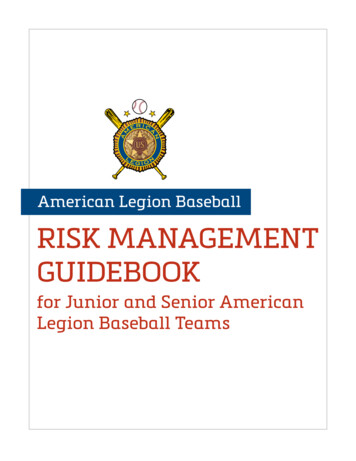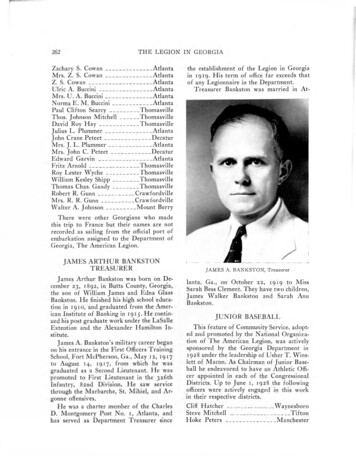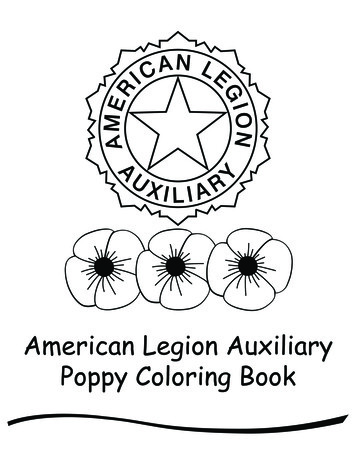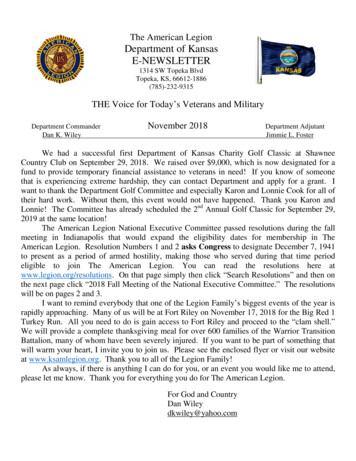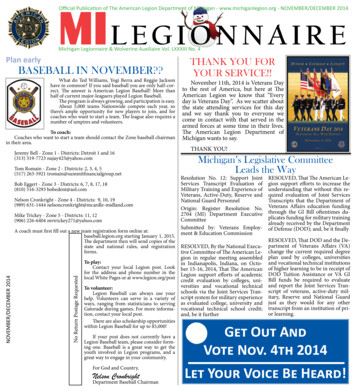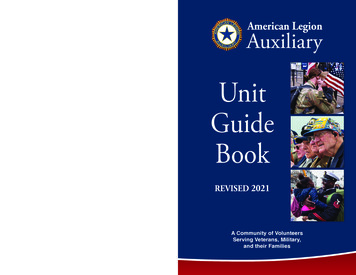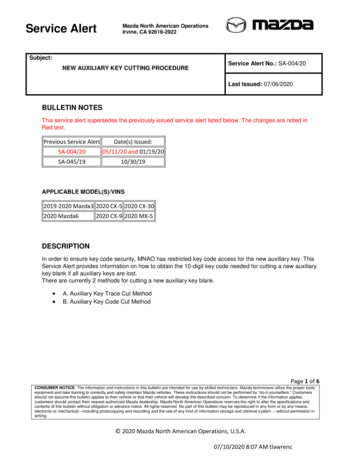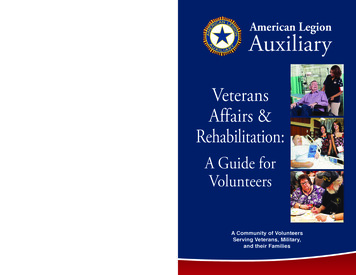
Transcription
American Legion AuxiliaryMission:In the spirit of Service Not Self, the missionof the American Legion Auxiliary is to supportThe American Legion and honor the sacrificeof those who serve by enhancing the livesof our veterans, military, and their families,both at home and abroad.For God and Country, we advocate for veterans,educate our citizens, mentor youth, and promotepatriotism, good citizenship, peace and security.American Legion AuxiliaryNational Headquarters3450 Founders RoadIndianapolis, IN 46268-1334P: (317) 569-4500 F: (317) g American Legion Auxiliary National HeadquartersAll rights reserved. 05/2022Produced in the USAAmerican LegionAuxiliaryVeteransAffairs &Rehabilitation:A Guide forVolunteersA Community of VolunteersServing Veterans, Military,and their Families
Veterans Affairs & Rehabilitation:A Guide for VolunteersRevised 2022American Legion Auxiliary Veterans Affairs & Rehabilitation: A Guide for Volunteers1
PREFACEThis guide book contains the policies and procedures of the AmericanLegion Auxiliary that govern volunteer service rendered by our members.The following volunteer programs, Veterans Affairs Voluntary Service(VAVS) and Service to Veterans (the combination of the American LegionAuxiliary programs formerly known as Field Service and Home Service)are a significant part of the Veterans Affairs & Rehabilitation (VA&R)Committee.Information pertaining to the VA&R Committee structure and budget isalso located in this guide book.For additional information about VA&R and its service programs, pleaserefer to the VA&R section of the national website atwww.ALAforVeterans.org.2American Legion Auxiliary Veterans Affairs & Rehabilitation: A Guide for Volunteers
TABLE OF CONTENTSIntroduction . . . . . . . . . . . . . . . . . . . . . . . . . . . . . . . . . . . . . . . . . . . . . . 4History . . . . . . . . . . . . . . . . . . . . . . . . . . . . . . . . . . . . . . . . . . . . . . . . . . 4American Legion Auxiliary Veterans Affairs & RehabilitationCode of Ethics . . . . . . . . . . . . . . . . . . . . . . . . . . . . . . . . . . . . . . . . . . . . 5Volunteer Recruitment and Retention . . . . . . . . . . . . . . . . . . . . . . . . . 7How Can American Legion Auxiliary Members Volunteer? . . . . . . . . 8Veterans Affairs Voluntary Service (VAVS) . . . . . . . . . . . . . . . . . . . . . 9Training . . . . . . . . . . . . . . . . . . . . . . . . . . . . . . . . . . . . . . . . . . . . 9Volunteer Opportunities . . . . . . . . . . . . . . . . . . . . . . . . . . . . . . 10Leadership Structure and Responsibilities . . . . . . . . . . . . . . . . 10Leadership Positions . . . . . . . . . . . . . . . . . . . . . . . . . . . . . . . . 11VAVS Certification Process . . . . . . . . . . . . . . . . . . . . . . . . . . . . 12Volunteer Recognition/Reporting . . . . . . . . . . . . . . . . . . . . . . . 12Service to Veterans Volunteers . . . . . . . . . . . . . . . . . . . . . . . . . . . . . 14Training . . . . . . . . . . . . . . . . . . . . . . . . . . . . . . . . . . . . . . . . . . . 14Volunteer Opportunities . . . . . . . . . . . . . . . . . . . . . . . . . . . . . . 14Leadership Structure and Responsibilities . . . . . . . . . . . . . . . . 15Volunteer Recognition . . . . . . . . . . . . . . . . . . . . . . . . . . . . . . . 15Hour Accreditation Process . . . . . . . . . . . . . . . . . . . . . . . . . . . 16Reporting Volunteer Hours . . . . . . . . . . . . . . . . . . . . . . . . . . . . 16American Legion Auxiliary Veterans Affairs & RehabilitationCommittee . . . . . . . . . . . . . . . . . . . . . . . . . . . . . . . . . . . . . . . . . . . . . . 17National VA&R Leadership . . . . . . . . . . . . . . . . . . . . . . . . . . . . 18Department VA&R Leadership . . . . . . . . . . . . . . . . . . . . . . . . . 19District and County Leadership . . . . . . . . . . . . . . . . . . . . . . . . 22Unit Leadership . . . . . . . . . . . . . . . . . . . . . . . . . . . . . . . . . . . . 22Budget and Funding . . . . . . . . . . . . . . . . . . . . . . . . . . . . . . . . . . . . . . 23Events and Ongoing Programs . . . . . . . . . . . . . . . . . . . . . . . . . . . . . 24Closing . . . . . . . . . . . . . . . . . . . . . . . . . . . . . . . . . . . . . . . . . . . . . . . . . 26Resources . . . . . . . . . . . . . . . . . . . . . . . . . . . . . . . . . . . . . . . . . . . . . . .27Glossary of Commonly Used Terms . . . . . . . . . . . . . . . . . . . . . . . . . 28Helpful Information for Volunteers . . . . . . . . . . . . . . . . . . . . . . . . . . 30American Legion Auxiliary Veterans Affairs & Rehabilitation: A Guide for Volunteers3
INTRODUCTIONIn April 1946, The American Legion Family joined forces with severalother veterans service organizations, including the U.S. Departmentof Veterans Affairs (VA), to form what is known as Veterans AffairsVoluntary Service (VAVS). Today, American Legion Auxiliary (ALA)volunteers serve alongside members of the community as VAVSvolunteers and as volunteers through the Auxiliary’s own Service toVeterans program. The information included in this guide book is meantto educate members on everything from what to expect as a volunteer,to the obligations of the organization and its leadership structure on anational, state, and local level.HISTORY OF THE FORMAL VETERANS AFFAIRS &REHABILITATION VOLUNTEER PROGRAMSince World War I, the women of the American Legion Auxiliary havetaken an active role in the care and rehabilitation of veterans. Theseearly efforts, however, were largely uncoordinated and not integratedinto a formal healthcare plan or program. It wasn’t until 1930 that careand rehabilitation for veterans were integrated under a unified VeteransAffairs program similar to what we know today.During World War II, it was determined that a need existed for acoordinated volunteer effort to direct the activity of committed individualsand hundreds of service and welfare groups such as the Auxiliary. Thisneed developed into a formal volunteer program providing aid andassistance to members of the armed forces injured in war.By the end of the war, the immediate focal point of interest for manyvolunteer groups seemed lost; however, leaders of these groups realizedthat the training these volunteers had received during wartime shouldn’tbe lost, and a new outlet for their efforts had to be identified.Since these volunteers had focused specifically on aiding and assistingservicemembers, it was only natural that leadership of the groups theyrepresented decided to focus their time, skill, and effort in peacetime,helping care for a new group of men and women now consideredveterans.On April 8, 1946, representatives of several veterans serviceorganizations, including The American Legion and the American LegionAuxiliary, met in Washington, D.C., with the Assistant Administratorfor Special Services. This meeting resulted in the still new VeteransAdministration developing regulations and procedures making a4American Legion Auxiliary Veterans Affairs & Rehabilitation: A Guide for Volunteers
provision for the use of volunteers through the VA Special Servicesprogram for hospitalized veterans. Before this meeting concluded, theirfirst VA Voluntary Service (VAVS) Advisory Committee was formed.Quickly, the VA realized the potential of a coordinated volunteer effort.Less than a year later, on Feb. 12, 1947, the scope of the VAVS planwas widened to include coordination of volunteer aid in all appropriatephases of the VA medical center program.In later years, as more wars ensued, the American Legion Auxiliaryheeded the call for volunteers. In 1964, the Auxiliary inaugurated a newprogram called Field Service Volunteers. Answering a need and call toaction, in 1974 the ALA introduced the Home Service program whichrecognized and supplemented the care given to America’s veterans.In 2013, the American Legion Auxiliary convention body voted tocombine Field Service and Home Service hours under an umbrellacalled Service to Veterans. As it stands today, under direction of theALA’s Veterans Affairs & Rehabilitation Program, members serveas VAVS volunteers and as Service to Veterans volunteers. VAVSvolunteers must serve in a VA healthcare facility (VA medical centers,VA hospitals, clinics, etc.), whereas Service to Veterans volunteerscan serve from their homes or in the community with other serviceorganizations.Regardless of where service takes place, American Legion Auxiliarymembers are known across the country as a go-to resource for thiscountry’s veterans and their families. The Auxiliary membership is proudof its legacy of volunteer service, and it is our goal to continue ourvaluable contribution in the years to come. Both programs continue toreflect our care, commitment, and compassion for veterans.AMERICAN LEGION AUXILIARY VETERANS AFFAIRS& REHABILITATION CODE OF ETHICSThe ALA has adopted a code of ethics to guide both VAVS and Serviceto Veterans volunteers while serving in their communities. This code ismeant not only to protect veterans and their families, but also to protectvolunteers and the integrity of the service programs.Compassion, Dignity, and Respect: As a volunteer, your mainpurpose is to make sure all veterans and servicemembers are treatedwith the compassion, dignity, and respect they have earned anddeserved. This includes but is not limited to engaging in thoughtfulconversations as well as listening without judgment.American Legion Auxiliary Veterans Affairs & Rehabilitation: A Guide for Volunteers5
Engaging in thoughtful conversation: Do not bring up topics related toa veteran or servicemember’s experiences during war (e.g., shootings,missions, or loss of other servicemembers). These topics will surfaceafter you have had time to build trust and should come only from theveteran or servicemember initiating the conversation. No veteran orservicemember should ever be put on the spot to discuss details of his orher military service.Listen without judgment: As a volunteer, it is important that you listenwithout judgment. Sometimes, these conversations can be difficult tohear. Listen with an open heart, and allow the veteran or servicememberto talk for as long as he or she wishes. Remember: As a volunteer, it isnot your job to counsel or offer advice to the servicemember, veteran, orfamily member.Confidentiality: All information concerning a veteran, patient, staffperson or other volunteer and the record of treatment or service is to bekept confidential and shared with no one. Consider familiarizing yourselfwith the Health Insurance Portability and Accountability Act of 1996(HIPAA), which protects the rights of individuals in a healthcare setting.More information can be found online: www.hhs.gov/hipaa/index.html.Dress and Attitude: It is expected that volunteers, regardless of theirsetting, will dress appropriately for the circumstance. This meansAmerican Legion Auxiliary branded attire when appropriate. Those ina healthcare facility will adhere to the code of that facility. It is furtherexpected that when “on duty,” volunteers will be pleasant, cordial, helpful,and positive.Professional Behavior: Following rules and assignments: As a volunteer, you are requiredto accept and follow rules and instruction as given by the authorityof the facility. If asked to do something you do not agree with, youhave a right not to accept the assignment. If the assignment ismission critical at the point in which it is given, fulfill the request,and express concern after the fact, in private, with the appropriateindividual – your direct supervisor, the ALA rep/dep, or the VAVSdirector. Working with veterans/patients, families, VA staff and othervolunteers: Do not publicly criticize the home or facility. Suchcriticism is disloyal and must be avoided. If there is a reason forcriticism, bring it to the attention of the appropriate person who willcommunicate any issues through proper channels.6American Legion Auxiliary Veterans Affairs & Rehabilitation: A Guide for Volunteers
Compensation discussion: It is never appropriate to discusspension or compensation issues with a veteran/patient. Thatindividual should be referred to the appropriate resource who istrained to respond to those types of questions. American Legionservice officers are trained to assist veterans with these types ofissues. These officers can be located through your local unit orpost.VOLUNTEER RECRUITMENT AND RETENTIONCaring for our veterans is at the core of the American Legion Auxiliarymission. We have a proud tradition to maintain. What can yourdepartment or unit do to ensure that the VA&R Program has thevolunteer resources it needs to get the job done? Work collaborativelywith your VAVS reps, your department’s hospital director, VA&Rchairman, department president, and VAMC Chief of VoluntaryService to coordinate your efforts to increase and diversify volunteeropportunities in each facility in your department to identify ways to servethe veteran population inside and outside VA healthcare facilities.Once a volunteer has received proper orientation and has beendetermined to be a good match for this service activity, it is everyone’sresponsibility to keep the flow of communication going, to promptlyresolve any misunderstandings in an amicable way, and to worktogether to solve any problems that prevent smooth and efficientservice.The biggest challenge the American Legion Auxiliary and other VSOsface is our approach to meeting the needs of an intergenerationalvolunteer force. How do we appeal to three to four generations ofpotential volunteers, each with its own unique mindset and valuesystem? Consider the following: When you are the point person for a service project, bewelcoming to all, regardless of an individual’s American LegionAuxiliary membership status. Look for opportunities to mentor other volunteers and to bementored; we all have unique talents and skills. Match personal and professional talent with interesting volunteeroptions. Offer volunteer service opportunities that have flexible hours.American Legion Auxiliary Veterans Affairs & Rehabilitation: A Guide for Volunteers7
When appropriate, invite your volunteers to bring a friend or familymember with them for a particular project. Listen with an open mind, and be willing to try to find a differentway to accomplish something. Provide opportunities where volunteers can grow personally andprofessionally. Identify challenging assignments where volunteers can see quickresults. Make use of technology in sending invitations for service projects;ask for help if you don’t know how.HOW CAN AMERICAN LEGION AUXILIARY MEMBERSVOLUNTEER?ALA members are able to volunteer in many different ways in any ofthe various committees within the organization. VA&R governs twocategories of ALA volunteers: VAVS volunteers and Service to Veteransvolunteers. While the goal of both programs remains the same, there aremany differences in how those goals are reached. The most significantdifference between the two programs pertains to where the service takesplace and how volunteers are recognized for their service.In the following sections, the specific differences between VAVS andService to Veterans have been outlined. While reviewing the differentprograms, consider how other members of your community can becomeinvolved. ALA obtains members through attraction. By organizingvolunteer events in the community, you are not only attracting attentionto the ALA’s mission but also educating the community on the needs ofservicemembers, veterans, and their families.8American Legion Auxiliary Veterans Affairs & Rehabilitation: A Guide for Volunteers
VETERANS AFFAIRS VOLUNTARY SERVICE (VAVS)VAVS (Veterans Affairs Voluntary Service) supports VA (U.S. Departmentof Veterans Affairs) and VHA (Veterans Health Administration) strategicgoals by recruiting, supporting, and retaining a knowledgeable,diverse, and engaged supplemental workforce of volunteers to assistmanagement in the delivery of VA healthcare by improving access tocare, assisting with long-term care, improving patient satisfaction andmuch more. The Auxiliary is not the only group that provides VAVSvolunteers, but we do have representatives who serve on the VA’sNational Advisory Committee.VAVS TrainingWhile some consistency exists within the VA Healthcare System, eachfacility is responsible for the orientation and placement of volunteers. Asa new volunteer to a VA facility, you should expect the following: An interview with a member of the Voluntary Services staff todiscuss your skills, interest, and intent. A formal orientation program produced and scheduled by thefacility: facility, staff, and policy information. Regularly Scheduledvolunteers will be fingerprinted, undergo a background check, bephotographed for an ID and given a tuberculosis test. For somepositions, the VA also requires special training (e.g., computeraccess or feeding patients). Different types of volunteers make up the VAVS. You will need todecide what you qualify for and how much time you would like todonate. Consider one of the following classifications:1. Senior Volunteer (21 years or older) Regularly Scheduled Volunteer: An individual who hasregistered in the VAVS program in a regularly scheduledassignment under VA supervision and who has beenfingerprinted and completed a background check andvolunteer orientation through a VA facility. Occasional Volunteer: An individual who works an ad-hocschedule reporting to the VAMC Voluntary Service Officefor assignments when on site.2. Student Volunteer: VA term for volunteers under 21 years ofage, with students under age 18 having written parental orguardian approval to participate in the VAVS program.American Legion Auxiliary Veterans Affairs & Rehabilitation: A Guide for Volunteers9
VETERANS AFFAIRS VOLUNTARY SERVICE (VAVS)3. Non-ALA members are welcome to become VAMCvolunteers having their hours counted to the benefit of theAuxiliary. Nonmembers are eligible for recognition andawards. Sign in at the beginning of each shift. All VA facilities now trackyour volunteer hours electronically. This sign-in is important forseveral reasons: ensures coverage under Federal Tort Claimsand for Worker’s/Workman’s Comp; serves as the official recordof volunteer hours; and guarantees that the American LegionAuxiliary is credited properly. ALA hours, as well as The AmericanLegion’s, are recorded in their annual report to Congress, soaccurate recording is critical. The VA’s annual tracking runs fromOct. 1 to Sept. 30, while the Auxiliary’s hours are tracked from April1 to March 31. Consider using your own personal system to trackyour hours. Report these hours to your unit to be included in theALA’s annual impact numbers. Uniforms: Follow the dress code ofyour particular VAMC. When permissible, wear ALA branded attireso veterans and VA personnel know who you represent.VAVS Volunteer OpportunitiesAs a VAVS volunteer, opportunities exist at Veterans Affairs medicalcenters (VAMCs) across the country. Volunteers participate in everythingfrom greeting servicemembers, veterans, and their families as they enterVAMCs to assisting VAMC staff with administrative duties. Volunteers willbe placed in different positions depending on need and availability. VAVScoordinates all volunteer services for the 1,200 medical facilities and125 cemeteries around the country. Volunteers can expect to volunteer atthe following facilities: Veterans Affairs Medical Center (VAMC): With more than 150locations around the country, VAMCs provide professional medicalcare in a hospital-like setting. Community Based Outpatient Clinic (CBOC): Clinics around thecountry supplement VAMCs by supplying outpatient services.VAVS Leadership Structure and ResponsibilitiesJust like the Veterans Affairs & Rehabilitation Program, and theAmerican Legion Auxiliary, VAVS has structured leadership who carryresponsibilities within the organization. Part of VAVS national leadershipis made up of Auxiliary members who serve as the national ALA10American Legion Auxiliary Veterans Affairs & Rehabilitation: A Guide for Volunteers
VETERANS AFFAIRS VOLUNTARY SERVICE (VAVS)representative (called a “rep”), national ALA deputy representative (calleda “dep”) and national ALA VAVS Certifying Officer. Auxiliary membersalso serve as ALA representatives and deputy representatives at theVAMC.Each VAMC allows one representative and up to three deputyrepresentatives per organization to serve on the facility’s VAVScommittee. It is important that department leadership ensures there areno vacancies in the representative positions and that at least one deputyrepresentative position is filled at each facility.Leadership PositionsNational VAVS Representative and Deputy Representative:In addition to a detailed job description prescribed by the AmericanLegion Auxiliary and the VA Office of Voluntary Services that isavailable on request by emailing VA&R@ALAforVeterans.org,the national VAVS rep and the deputy represent the Auxiliary onthe national level through participation in the National AdvisoryCommittee. The National Advisory Committee meets twiceannually, typically in the spring and fall. The representative is alsoactively involved in a subcommittee and study group as appointed,makes recommendations for policy change, and addressesvolunteer issues of national significance. They work closely withthe ALA’s national VA&R chairman on evaluating the overallparticipation of the Auxiliary in recognized voluntary service.Department-Level VAVS Representative/DeputyRepresentative:Appointed by the department president and certified by the ALA’snational president, these individuals report directly to a VAMCdirector and coordinate American Legion Auxiliary volunteeractivity at a specific VA healthcare facility. For further details ondepartment-level responsibilities as a representative and deputyrepresentative, refer to responsibilities in Department-LevelStructure.Note on representing multiple organizations: A rep/dep to a VAMCrepresenting the ALA may not hold the same position for anotherorganization.(ALA) Department Hospital Center Director:Nearly two-thirds of American Legion Auxiliary departments haveAmerican Legion Auxiliary Veterans Affairs & Rehabilitation: A Guide for Volunteers11
VETERANS AFFAIRS VOLUNTARY SERVICE (VAVS)a volunteer position that coordinates the efforts of its activities in VAmedical centers located within the state.National ALA VAVS Certifying Officer:This position is held by the American Legion Auxiliary nationalpresident. The national certifying officer is responsible for signing offon all representative and deputy changes that may occur throughouttheir term as ALA national president.VAVS Certification ProcessThe official department representative submits certification reflectingchanges on a completed official VAVS certification form found atwww.ALAforVeterans.org.Volunteer Recognition/ReportingService to Veterans Volunteer Hour Recognition by theAmerican Legion AuxiliaryThe American Legion Auxiliary has a tradition of recognizing timeand service through the use of Service to Veterans pins and hourbars. Formal recognition is the same for Hospital, Senior, or StudentVolunteer members and nonmembers who represent the ALA atU.S. Department of Veterans Affairs facilities as well as during unitand/or post activities serving veterans.Volunteer hours are certified by department secretaries in accordancewith department procedures. Once a volunteer has reached amilestone in their accumulated hours, the department secretary willsend certification to ALA National Headquarters. This certification formis located at www.ALAforVeterans.org and requires the member’sname, membership ID number, and the hour bar needed.Please note: Some departments recognize hospital service separatelyfrom Service to Veterans and award hour bars for each of the twocategories. These numbers may be combined for Service to Veteransrecognition, thus resulting in higher cumulative hour bars awarded.Order Fulfillment – Hour BarsUpon receipt of certification, ALA National Headquarters will sendthe appropriate bars to the designated department representative.Volunteers are recognized when specific hour milestones arereached: 50, 100, 300, 500, and 1,000. After the first 1,000-hour bar12American Legion Auxiliary Veterans Affairs & Rehabilitation: A Guide for Volunteers
VETERANS AFFAIRS VOLUNTARY SERVICE (VAVS)is awarded, the next bar will be earned in 1,000-hour incrementsup to 20,000 hours. The next hour bars are available at 25,000hours and 30,000 hours. After a volunteer has reached 35,000hours, they will be awarded a Lifetime Service to Veterans pin.Hour Bar PinsDepartment secretaries order pins from American Legion Flag& Emblem Sales. Generally, departments will purchase pins fortheir members when possible; in some cases, the individual mustpurchase their own pin. These items are considered special ordersand therefore are not listed online or in the catalog. You must callAmerican Legion Flag & Emblem Sales at 1-888-453-4466 to placean order. Pins will be sent to the person making the order on behalfof the volunteer. Oftentimes, departments honor their volunteers atconferences and annual meetings and present pins or additionalhour bars at those times. ALA National Headquarters provides hourbars that have been earned and certified by departments free ofcharge to the department representative.VAVS Volunteer ReportingIt is important that all hours served by VAVS volunteers arereported to the appropriate party in a timely manner. VAVSvolunteer hours should be compiled by a VAMC’s representativeor deputy representative. Those hours then should be reported tothe national VAVS representative or deputy representative. Therepresentative or deputy representative sends these hours to ALANational Headquarters, where they are passed on to The AmericanLegion to be reported to Congress.Note: The VA has its own system for tracking volunteer hours withinVA facilities. American Legion Auxiliary members who volunteercan use both hours volunteering in a VA facility combined with anyvolunteer hours in Service to Veterans outside a facility toward hourbars awarded by the ALA national organization.Service to Veterans volunteers are American Legion Auxiliary members whoprovide service to veterans outside a VAMC. Whether organizing a standdown, assembling care packages/tray favors/greeting cards, assisting witha veteran’s burial or gravesite upkeep, sewing, cooking, or shopping foractive-duty military/veterans and/or their families, member volunteers are atthe heart of the Veterans Affairs & Rehabilitation Program structure.American Legion Auxiliary Veterans Affairs & Rehabilitation: A Guide for Volunteers13
SERVICE TO VETERANS VOLUNTEERSService to Veterans TrainingWhile there is no formal ALA Service to Veterans training program requiredon a national level, every fall ALA National Headquarters leadership andstaff offer the “VAVS (VA Voluntary Service) Department Orientation”webinar for department presidents, secretaries, VA&R chairmen and VArepresentatives and deputy representatives. This webinar covers the basicsof the VA and volunteering within the VA.Service to Veterans Volunteer OpportunitiesAfter a member has completed their orientation (if required in yourdepartment) or has made the decision to volunteer outside of a VAMC,the first step should be to identify a servicemember, veteran, and/or familymember’s needs within the community. Consider the following when tryingto locate where to identify these needs: Start with your own post home. Some Legionnaires are now aged,infirmed, confined due to illness or inability to drive, and spend mostof their time at home or in assisted living facilities. Utilize leaders in your community. Contact government officials,religious leaders, and social service offices to ask about differentprograms in the community serving veterans. Once you haveobtained contact information, reach out to the various organizationsand ask them to identify their needs.Once you have identified the needs in your community, brainstormdifferent ways to meet these needs with your unit or American LegionFamily. Following is a list of ideas to get you started: Visit with veterans and remember them on special occasions. Offer to drive veterans to doctor appointments. Offer to stay with a veteran while his/her primary caregiver goesshopping or out for a break. Take a veteran for a Sunday drive, picnic, or maybe to see one ofhis/her friends. Treat veterans to tickets for sporting events or movies. Transitional housing programs have many needs. Secure donationsfor staple items such as laundry soap, cleaning supplies, kitchenitems, new undergarments, etc. Donate a membership to The American Legion. Arrange an outing toa Legion meeting for special events such as a Veterans Day dinner,memorial service, etc.14American Legion Auxiliary Veterans Affairs & Rehabilitation: A Guide for Volunteers
SERVICE TO VETERANS VOLUNTEERS Furnish a room in transitional housing programs as a special project. Help furnish new living space for a veteran graduating from a transitionalhousing program. This might include the veteran and his/her family.School supplies for children or meals might be extra touches.Service to Veterans Leadership Structure and ResponsibilitiesService to Veterans has been designed to give members a chance tovolunteer in their communities without the structure of a VAMC. If adepartment has a very high number of volunteers, they might have aService to Veterans director or chairman responsible for collecting VA&Rservice hours and requesting hour bars from the department secretary fortheir department. In most cases, this responsibility is most likely handledby a member of the VA&R Committee.Service to Veterans Volunteer RecognitionHour bars for your Service to Vete
National Headquarters 3450 Founders Road Indianapolis, IN 46268-1334 P: (317) 569-4500 F: (317) 569-4502 . Hour Accreditation Process . 16 Reporting Volunteer Hours . 16 American Legion Auxiliary Veterans Affairs & Rehabilitation . early efforts, however, were largely uncoordinated and not integrated into a formal healthcare plan .
